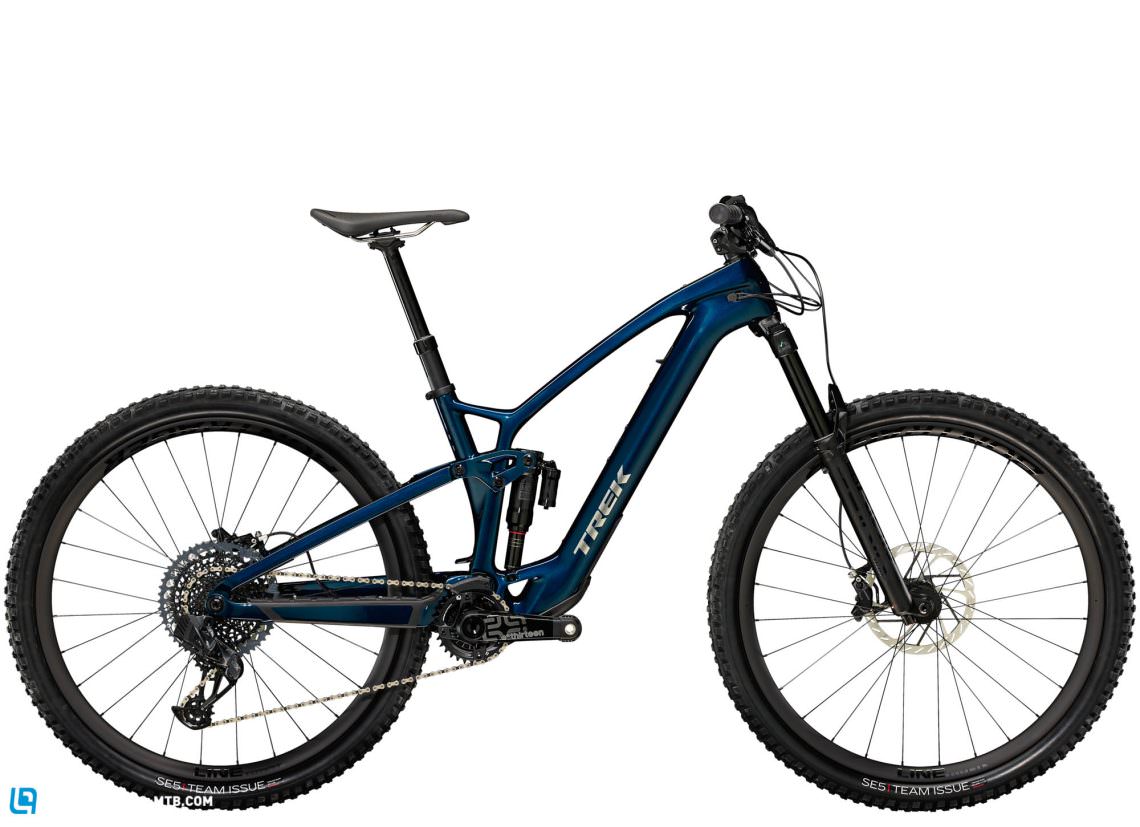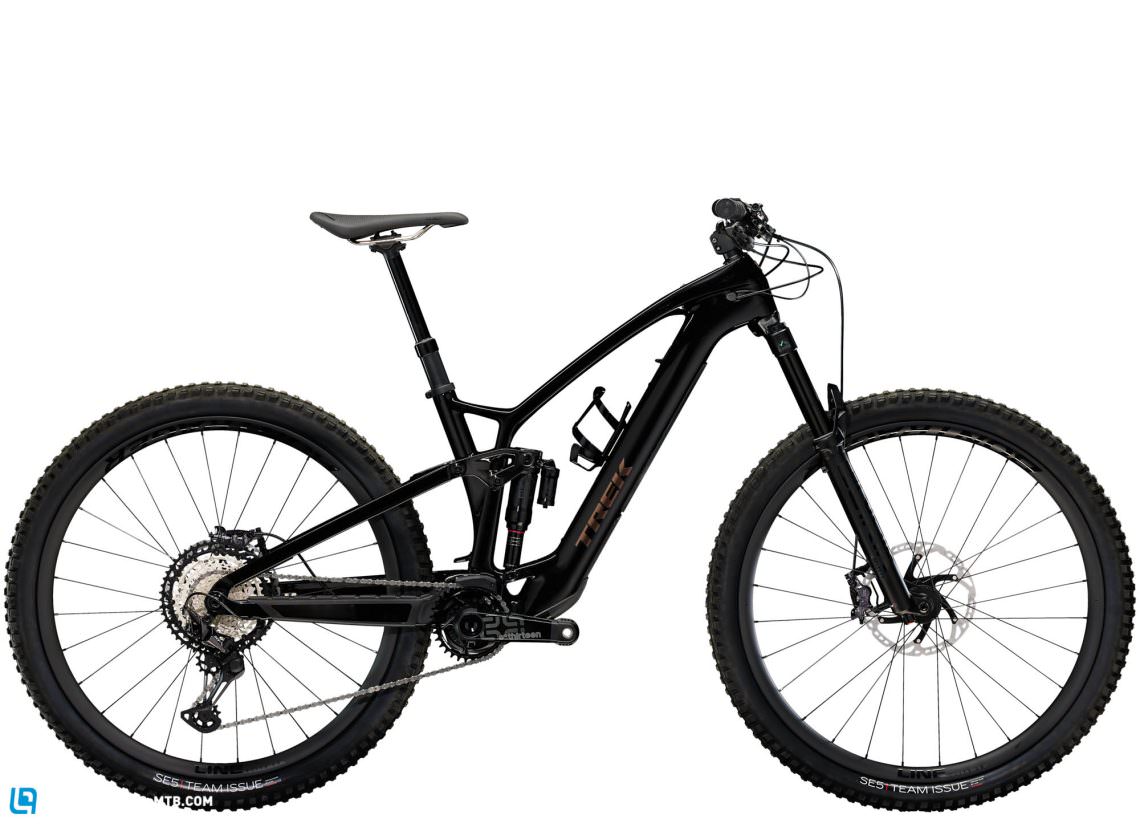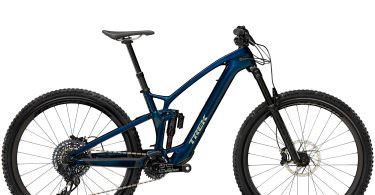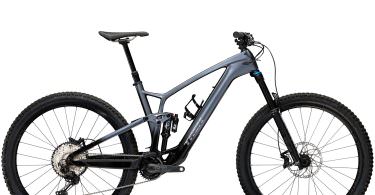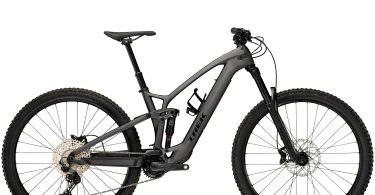With the new Fuel EXe 2023, American bike giant Trek and Bavarian motor manufacturer TQ are heralding a new generation of eMTBs. According to Trek’s own statement, the new Fuel EXe 9.9 XX1 AXS 2023 with TQ HPR 50 is the eMTB with the most natural ride feel built to date. We’ve already tested the bike over a period of four weeks and can tell you what it’s capable of. Spoiler alert: We’ve never looked as inconspicuous onboard an eMTB as with Trek’s 18.9 kg electric trail bruiser.
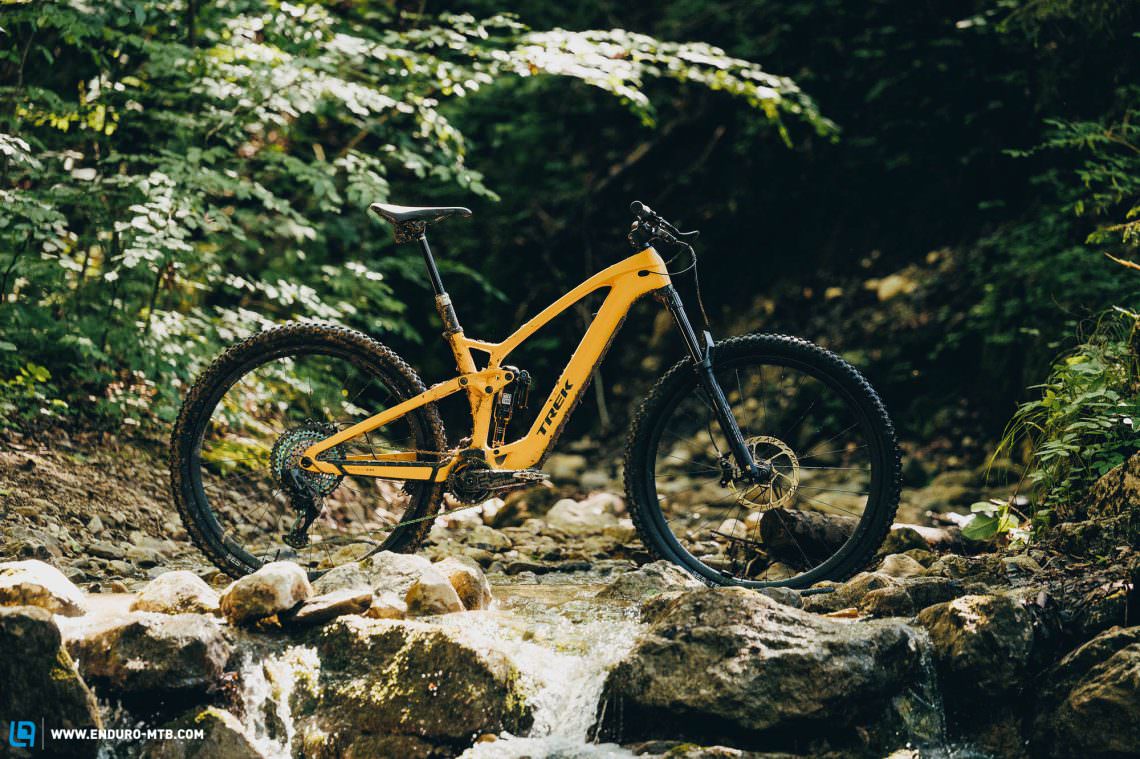
18.9 kg in size L | € 14,999 | Manufacturer’s website
Increasingly more eMTB manufacturers seem to follow the “ride further, for longer and with more power” mantra while developing new bikes, engaging in a savage battery and motor power arms race. But that’s about to change soon! At the beginning of 2022, FAZUA introduced a new lightweight motor system, inciting the competition to follow suit. With the new Fuel EXe, Trek are favouring a light and natural ride feel over huge range and raw power, promising to deliver an experience similar to that of an analogue mountain bike. After introducing the lightly-assisted E-Caliber XC racer with FAZUA, in 2022 Trek are unveiling the Fuel EXe with brand new TQ motor following years of intensive development work. The new drive system of the Bavarian electronics solution provider churns out 50 Nm torque and was developed in close cooperation with Trek, which explains why the motor can only be found on Trek models for the time being. In this article you’ll find out how the TQ motor compares to the new FAZUA Ride 60. Trek’s new light eMTB is built around the Fuel EX frame platform, which combines 150 mm travel at the front and 140 mm at the rear. The motor draws its power from a 360 Wh battery, which is integrated in the down tube of the carbon frame and can be complemented with a 160 Wh range extender. Thanks to the low 3,650 g system weight of the HPR 50 motor and battery system, the Trek Fuel EXe 9.9 XX1 AXS tilts the scales at just 18.9 kg. However, this all comes at a price, with the new Fuel EXe 9.9 XX1 AXS 2023 retailing at an eye-watering €14,999.

The new Trek Fuel EXe 9.9 XX1 AXS 2023 in detail
While the name of Trek’s new light eMTB clearly reveals its origins – the analogue Trek Fuel EX – its frame has been redesigned around the TQ drive and given a little extra travel. However, the electric version retains some of the frame details of its analogue precursor including the generous seat and chainstay protectors. The rear brake line and motor cables are routed internally but aren’t clamped at the ports or guided inside the frame properly, causing an annoying rattling noise on the trail during our test runs. The cables reemerge from the frame just above the motor only to disappear into the swingarm again, protected from grit and dirt by a small plastic fender at the transition between the main frame and rear triangle.
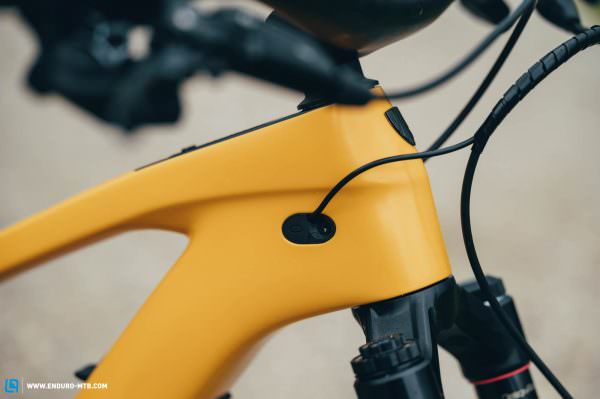
The motor cables and the rear brake line (especially!) aren’t clamped at the ports properly.

A small plastic fender protects the cables from dirt and mud.
On the down tube, a generously-sized two-piece TPU plate protects the frame against impacts and the lower section can be unbolted to access the battery. To remove the latter from the down tube, we recommend turning the bike upside down. The frame of the Trek Fuel EXe features a mounting point for all conventional tool straps on the top tube and a second one for a bottle cage on the down tube. When using both, however, there’s very little room left for a water bottle in the main frame triangle, even with our size L test bike. Trek also deliver the Fuel EXe with their proprietary Bontrager BITS tool kit, which is cleverly integrated into the steerer tube and includes all tools for basic trailside repairs – awesome! Unfortunately, the locking system of the tool kit is a bit loose, causing some rattling on the trail.

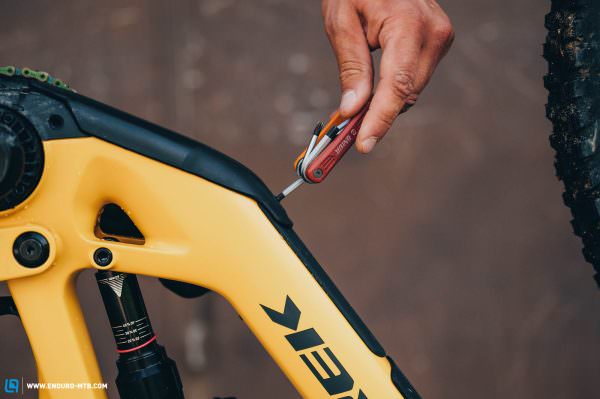
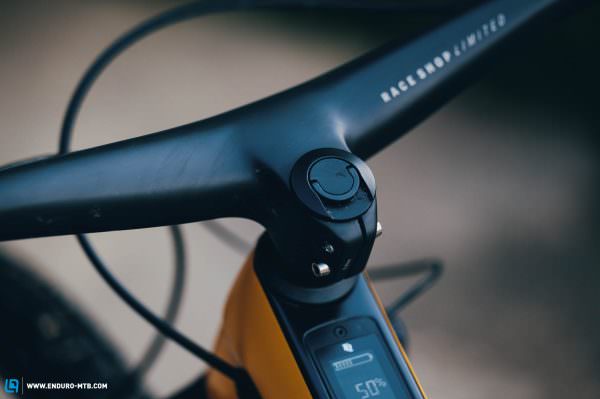
Unfortunately, the multi tool doesn’t lock in place properly and rattles inside the steerer tube on rough trails.
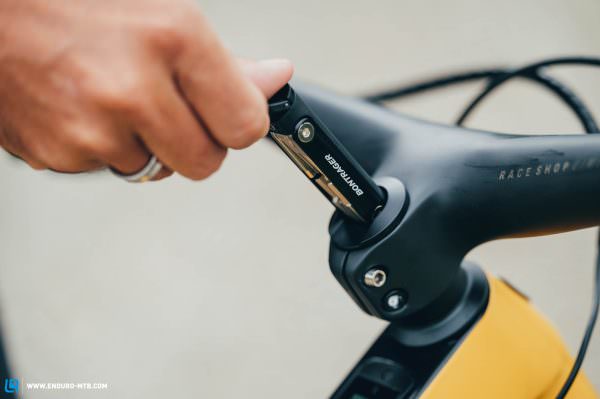
Trek’s proprietary Bontrager BITS multitool hidden inside the steerer tube allows you to carry out all essential trailside repairs.
German manufacturer TQ and their new HPR 50 motor
Who’s behind TQ and what’s the Bavarian motor up to?
German electronics solution provider TQ was founded in Bavaria in 1994 and the cryptic acronym stands for “technology in quality”. The company now employs more than 1,700 people worldwide and specialises in the development and production of electric motors for robots, satellites, space stations and even Mars rovers. However, the German company has also been busy developing e-drives for bicycles over the past 14 years (2008) and is best known for its extremely powerful (and loud) TQ HPR 120S drive, which churns out a whopping 120 Nm torque. The system can be found mainly on the bikes of German manufacturer Haibike and employs the same technology as the new HPR 50. Ten years after debuting in the eMTB segment with their HPR 120S drive, TQ teamed up with bike manufacturer Trek to develop the new system, which was finally presented to the public after four years in the making. The HPR 50 motor is developed and produced in Inningen, Germany, which is home to the headquarters of the German tech brand. All peripherals of the drive system will be manufactured in Europe too. In our TQ factory visit story you can read everything about the German manufacturer and their brand philosophy while getting an exciting insight into the strategic realignment and production of the new motor.

The new TQ HPR 50 motor and new 360 Wh TQ HPR battery
Like its big HPR120S sibling, the HPR 50 motor employs TQ’s proprietary harmonic pin-ring transmission. This has a 1:17 gear ratio, which is relatively low for an ebike motor. In a nutshell, when pedalling at an 80 rpm cadence, the motor performs approximately 1,400 revolutions per minute, which is partly responsible for the drive’s low noise level. The motor has a maximum torque of 50 Nm and maximum nominal output of 300 watts. Motor assistance can be adjusted in three support levels, ECO, MID and HIGH, whereby the weakest ECO mode delivers a maximum of 99 watts and the MID mode generates up to 180 watts. When the charging level drops below approx. 10%, the system still delivers up to a maximum of 150 watts to get you home. The motor weighs 1,850 g. For comparison’s sake, the new FAZUA Ride 60 drive tilts the scales at 1,960 grams while the Shimano EP8 motor of the Orbea Rise comes up to a hefty 2,570 grams. If you want to know more about TQ’s new drive, you’ll find all the details in our FAZUA Ride 60 vs. TQ HPR 50 review.
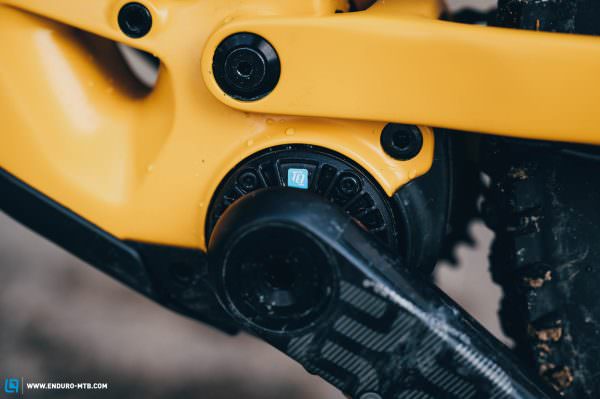

The motor draws its power from a 360 Wh battery developed in-house by TQ. This is secured to the frame by two bolts and can be easily removed from the down tube once the bolts are undone. Moreover, Trek will soon release an optional 160 Wh range extender that fits into the Fuel EXe’s bottle cage. When connecting the extender to the charge port in the down tube, the motor first draws its power from the range extender and only starts feeding off the main battery in the down tube once the extender is drained. According to Trek, the range extender doesn’t induce derating (output power decrease), allowing you to use the maximum 300 watts nominal output even with the range extender.


Both the main battery and the range extender can be charged on and off the bike using TQ’s proprietary charger – both at once! Since the range extender can be connected straight to the main battery, the process doesn’t require a Y cable. When charging, the sequence is inverted and the main battery gets priority over the range extender. Charging time for the first 80% is around 90 minutes while the remaining 20% takes between 2 and 3 hours – the slower charging is meant to protect the battery. When charging the battery on the bike, you just connect the cable to the main charge port, which is protected by a plastic cover and is the same you use to connect the range extender. When charging both batteries at once directly on the bike, you can connect the charger cable straight to the range extender.
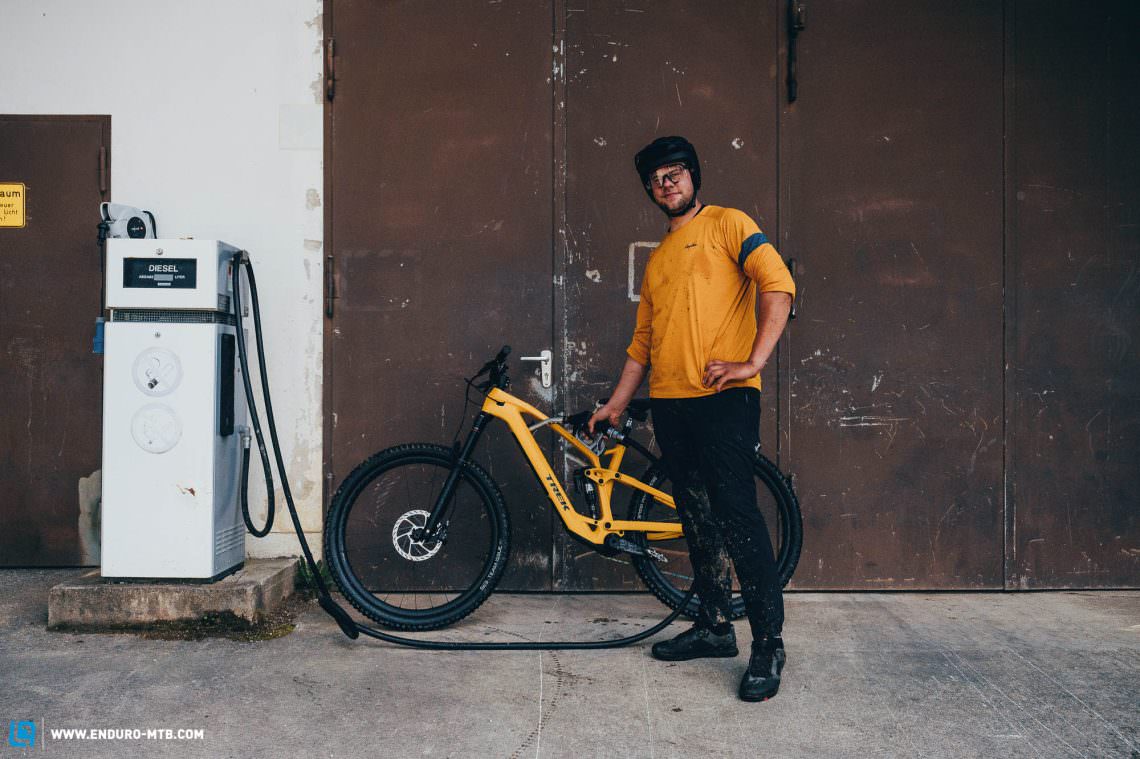
The TQ battery charges up to 80% in just 90 minutes, while a full charge takes between 2 and 3 hours.
The display and remote of the new TQ HPR 50 drive system
With the new Fuel EXe, Trek integrated TQ’s black and white display directly into the top tube. A small button below the 2″ display serves as the main power switch and at the same time lets you scroll between different display views. There’s a total of four display options to choose from, whereby all of them show the selected support level and battery charge status in 10% increments.

The battery charge status and current support level are displayed at the top and bottom of the display, respectively. Both parameters appear in all four display views.
The following display options are available:
- Real time speed and average speed
- Battery charge status in 1% increments and remaining riding time in the respective support mode
- Remaining distance in km and riding time in the respective support mode
- Rider and motor performance in watts
You can switch between the three support levels of the drive system from TQ’s proprietary and very discreet handlebar remote, which is connected to the system via a data cable. Moreover, the remote allows you to activate the so-called Walk mode and switch off motor assistance altogether. Unfortunately, the remote is made of thin plastic and thus particularly prone to damage – the one on our test bike already snapped off after a few adjustments.

The basic remote allows you to switch between support levels, activate Walk mode and switch off the motor altogether. That’s all the Trek Fuel EXe needs!
The companion app of the new Trek Fuel EXe and the TQ HPR 50 drive system
The TQ drive system can be paired with a smartphone or bike computer via Bluetooth and ANT+. To connect it to your phone, you’ll have to download Trek’s new app, which allows you to adapt the power, support level and pedal sensitivity of the individual support mode. The app will also give you an estimate of the remaining range for each support level. The “Range Cloud” displays a radius on a map that shows how far you’ll get with the remaining range. Unfortunately, the app wasn’t yet available at the time of this test, so we can’t tell you much more about it.
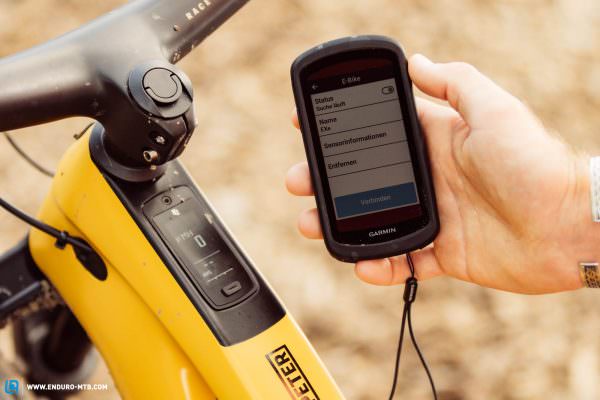
The new Trek Fuel EXe can be connected to all conventional bike computers via ANT+.
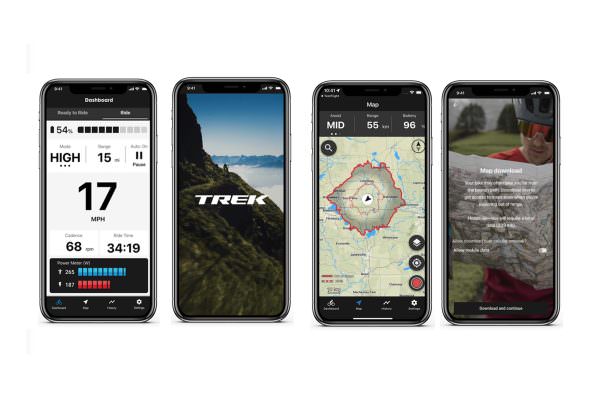
Via the companion app, you can adjust the motor settings to suit your needs and preferences, and access useful information about your route, setup and battery charge status.
Spec variants and availability of the Trek Fuel EXe 2023
As for now, the new Trek Fuel EXe will be released in six versions, all of which combine a carbon main frame and alloy rocker link. The bikes will be available from trusted Trek retailers from now on and retail between € 6,499 (Fuel EXe 9.5) and € 14,999 (Fuel EXe 9.9 XX1 AXS). Alongside the spec variant, you’ll be able to choose between three paint finishes. Moreover, Trek will soon add the Fuel EXe to their Project One program, allowing you to customise the look of your bike using their online configurator. Needless to say, this option will be charged separately.
Our test bike: the Trek Fuel EXe 9.9 XX1 AXS 2023
For this first ride review, we tested the 18.9 kg Fuel EXe 9.9 XX1 AXS flagship model, which puts a rather big € 14,999 dent into your bank account but already comes equipped with RockShox’s latest suspension components. Trek combine a Lyrik Ultimate fork with Charger 3 damper and Super Deluxe Ultimate shock with lockout lever and hydraulic bottom-out control, which both offer countless adjustment options. Moreover, the Americans throw in a TyreWiz sensor on the wheels and AirWiz sensor on the fork and shock, allowing you to monitor the respective air pressures in real time.

The new Fuel EXe comes equipped with the latest RockShox Lyrik fork with Charger 3 damper.
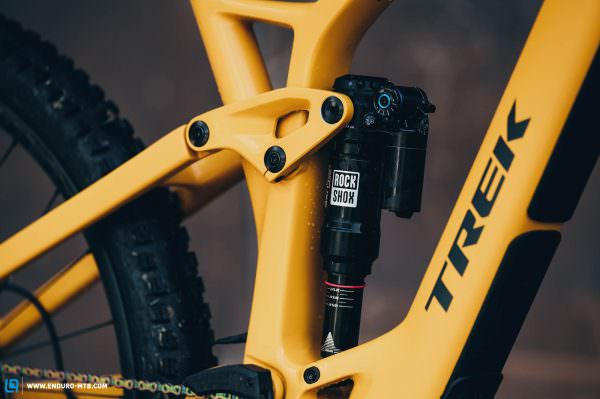
At the rear, the Trek employs a brand-new Super Deluxe Ultimate shock from RockShox’s 2023 suspension lineup, which features a hydraulic bottom-out control.
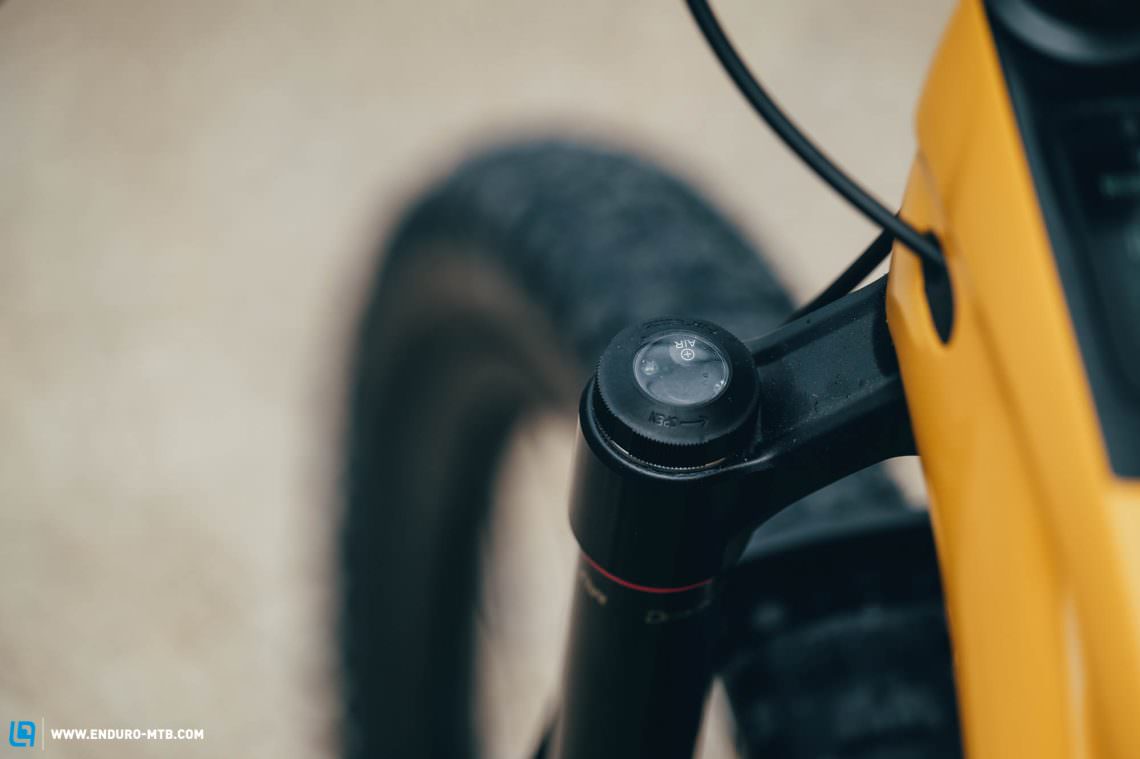
The new Trek Fuel EXe features TyreWiz and AirWiz sensors on the fork, shock and both tire valves, allowing you to check the respective air pressures in real time via the smartphone app. Using two LEDs, the system will also let you know whether you’re still “in the green’’ with your settings.
SRAM CODE RSC four-piston brakes ensure powerful and reliable deceleration. The RSC model features tool-free bite point and lever reach adjustments, and employs SRAM’s SwingLink lever, which was designed to minimize deadband. The brakes are paired with 200 mm SRAM HS2 brake rotors, which are meant to improve heat dissipation and thus the overall braking performance.

Big 200 mm SRAM HS2 rotors front and rear ensure powerful and reliable deceleration.
As the model name suggests, shifting is taken care of by an electronic and fully-wireless SRAM XX1 AXS 12-speed drivetrain, which usually draws its power from a small AXS battery hidden inside the rear derailleur. With the Fuel EXe, however, the rear derailleur is wired straight into the main battery, allowing you to dispense with one of the two AXS batteries and guaranteeing up to 300 gear shifts even once the main battery is drained. However, you still need an AXS battery for the wireless 170 mm RockShox Reverb AXS dropper post. While this can be inserted all the way into the frame, it’s still on the short side for a modern trail bike in size L.

A thin cable connects the electronic SRAM XX1 AXS rear derailleur with the main battery of the bike.
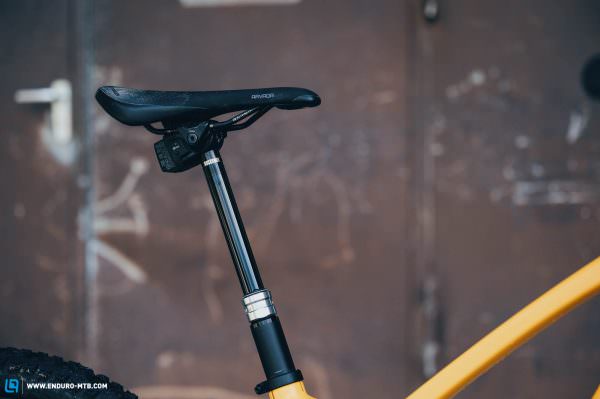
However, you still need an AXS battery for the RockShox Reverb dropper post, which at 170 mm, is on the short side for a modern Trail bike in size L.
For the rest of the spec, Trek rely almost entirely on their own-brand Bontrager components, including the elegant Bontrager RSL carbon cockpit. Unfortunately, the latter is extremely stiff and features wide 820 mm handlebars, which might be excessive for many riders – and cutting off the bars will make them even stiffer! Trek also rely on carbon for the wheels, employing a Bontrager Line Pro 30 carbon wheelset usually found on Trek’s downcountry models. The wheels are paired with 2.5″ Bontrager SE5 Team Issue tires with thin casing, which requires higher air pressure to prevent costly damage to the expensive carbon rims. Alternatively, you can upgrade the tires for a more robust model with tougher casing, which does more justice to the sporty character and intended use of the bike.

Trek Fuel EXe 9.9 XX1 AXS 2022
€ 14,999
Specifications
Motor TQ HPR 50 50 Nm
Battery TQ HPR Battery V01 360 Wh
Display TQ 0-LED
Fork RockShox Lyrik Ultimate 2023 150 mm
Rear Shock RockShox Super Deluxe Ultimate 140 mm
Seatpost RockShox Reverb AXS 170 mm
Brakes SRAM CODE RSC 200/200 mm
Drivetrain SRAM XX1 AXS 1x12
Stem Bontrager RSL Carbon 45 mm
Handlebar Bontrager RSL Carbon 820 mm
Wheelset Bontrager Line Pro 30 29"
Tires Bontrager SE5 Team Issue 2.5"
Technical Data
Size S M L XL
Weight 18.9 kg
Perm. total weight 136 kg
Max. payload (rider/equipment) 117 kg
Trailer approval no
Kickstand mount no
Specific Features
Toolmount
TyreWiz/AirWiz
integrated multitool
Range extender with 160-Wh
The geometry of the Trek Fuel EXe 2023
The new Trek Fuel EXe will be available in four frame sizes, S to XL. Our test bike in size L combines 482 mm reach with a pleasantly short 435 mm seat tube, ensuring excellent freedom of movement and allowing you to choose the frame size based on your desired reach. A flip chip in the rocker arm allows you to adjust the seat and head angle as well as the reach, bottom bracket height and chainstay length, which is consistent across all sizes and doesn’t grow with the frame size.
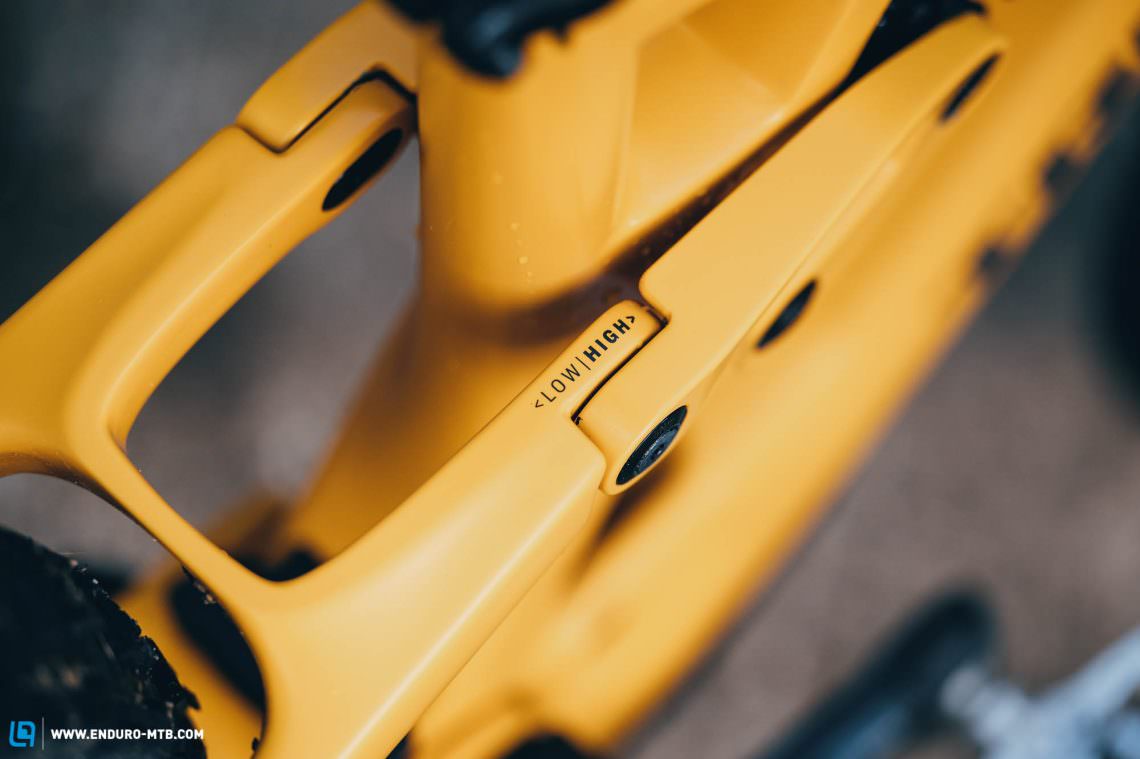
The flip chip in the rocker arm allows you to adjust the geometry of the Fuel EXe.
Trek deliver the Fuel Exe in the low setting and if you want to run a mullet setup with a smaller 27.5″ wheel at the rear, you’ll have to leave the flip chip in the higher setting. However, changing wheel size will automatically reduce the speed threshold at which the motor stops supporting and unfortunately this can’t be adjusted in the app.
The geometry of the Trek Fuel EXe 2023 in the low setting.
| Size | S | M | L | XL |
|---|---|---|---|---|
| Seat tube | 380 mm | 410mm | 435mm | 470mm |
| Top tube | 573 mm | 600 mm | 630 mm | 658 mm |
| Head tube | 100 mm | 110 mm | 110 mm | 120 mm |
| Head angle | 64.7° | 64.7° | 64.7° | 64.7° |
| Seat angle | 76,7° | 76,7° | 76,8° | 76,8° |
| Chainstay | 440 mm | 440 mm | 440 mm | 440 mm |
| BB Drop | 39 mm | 39 mm | 39 mm | 39 mm |
| Wheelbase | 1189 mm | 1218 mm | 1248 mm | 1277 mm |
| Reach | 427 mm | 452 mm | 482 mm | 507 mm |
| Stack | 620 mm | 629 mm | 629 mm | 638 mm |

How did the TQ HPR 50 motor fare in our first test?
With the new HPR 50 drive system, TQ’s development team wanted to achieve the most natural riding behaviour possible, thus enabling a ride feeling similar to that of an analogue mountain bike – and they really hit the nail on the head! In fact, the new HPR 50 motor conveys the most natural ride feeling we’ve ever experienced with an electric motor. Even under full load, the TQ HPR 50 emits a faint, pleasant whirring sound that is quickly drowned out by surrounding ambient noises. The motor engages and disengages almost unnoticed, making you feel extremely fit but still requires you to work hard on steep climbs. The TQ HPR 50 is relatively weak compared to most electric motors and has a relatively low torque of 50 Nm, thus requiring you to put in some work yourself. Moreover, the motor provides more support at high pedalling cadences. As a result, it’s less forgiving of wrong gear choices, making it hard to negotiate steep climbs in higher gears, even when riding in the most powerful HIGH mode.

When riding in ECO mode, the Fuel EXe moves at the same pace of a lightweight XC bike and doesn’t feel like a 19 kg trail bike. MID mode takes it up a notch, providing a cheeky gravel/Nino Schurter boost and allowing you to steam past your analogue friends with a smug grin on your face. And what happens when you drain the battery? In that case, the relatively low system weight and minimal motor resistance make it easy to pedal back home without too much effort.

If you’re looking for a natural mountain bike feeling rather than the typical eMTB kick, the new TQ HPR 50 motor system is a great way to get fitter – or at least to pretend to! On our test laps, very few hikers and mountain bikers noticed that we were riding assisted – and the Strava community didn’t either! In a nutshell, the TQ system takes the edge off nasty climbs and alleviates the suffering compared to motorless MTBs but still gives you a good workout, so you can have one or two isotonic drinks without feeling guilty.
What’s the Trek Fuel EXe 9.9 XX1 AXS 2023 capable of on the trail?
On level ground, the pedalling position is comfortable, although the wide 820 mm handlebars result in plenty of pressure on your hands. However, as the gradient rises the pressure eases and the Fuel EXe is still an excellent companion for long rides. On steeper climbs, the rear suspension isn’t the most pedal-neutral out there but doesn’t require a climb switch (partly due to the motor) and always generates sufficient traction, even on technical climbs.



Downhill, you’re nicely integrated with the bike and safely tucked away between its big wheels. This inspires huge amounts of confidence and encourages you to rip your way down into the valley. While the super-wide handlebars pull your upper body over the front, this position suits the bike’s character and ensures sufficient pressure on the front wheel to keep it tracking. The suspension provides a good mix of traction and support, allowing you to play with the trail and throw the bike from one side of the trail to the other without pushing the suspension to the limit. Nevertheless, the stiff cockpit ensures very direct feedback from the trail, requiring good skills and a vigilant riding style. However, when switching from an analogue mountain bike to the Trek Fuel EXe, the additional weight makes you feel as if you’re sitting on a bike with more travel, which can lead to unpleasant surprises in rough trail sections.

Our conclusions about the new Trek Fuel EXe 9.9 XX1 AXS 2023
The Trek Fuel EXe with TQ HPR 50 motor ushers in a new generation of light eMTBs that makes the analogue mountain bike world shake. With its quiet drive and clever motor/display integration, the Trek Fuel EXe 2023 is hardly recognizable as an eMTB. On the trail, the motor is extremely discreet and you’ll only notice it once it’s turned off. All of this makes the Trek a great companion for sporty riders who still want to get a good workout on a ride.
Tops
- Tidy display integration and minimalistic remote
- Natural and quiet drive system
- Motor and bike character harmonise well
- Excellent overall package
Flops
- Spec with some inconsistencies
- Cables rattle inside the frame

For more info visit the Trek’s website.
Did you enjoy this article? If so, we would be stoked if you decide to support us with a monthly contribution. By becoming a supporter of ENDURO, you will help secure a sustainable future for high-quality mountain bike journalism. Click here to learn more.
Words: Peter Walker Photos: Christoph Bayer / Trek, Peter Walker




